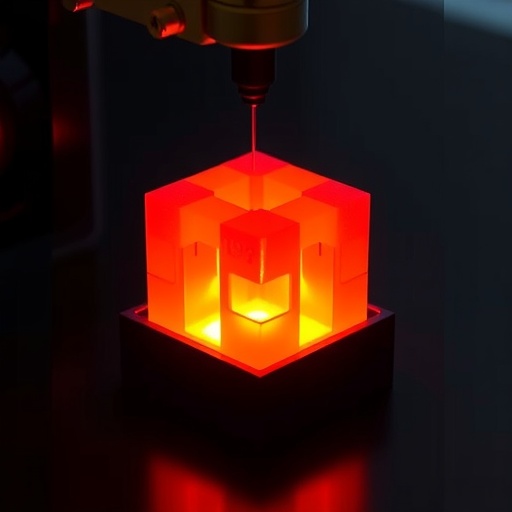In an era where the need for innovative manufacturing techniques is at an all-time high, researchers are pioneering the way with the development of a transformative three-dimensional printing method that engages thermoset materials. The integration of cutting-edge technology in the form of in situ laser-induced solidification with direct ink writing is making waves in the realms of flexible electronics and soft robotics. This newly developed technique is truly game-changing, allowing for the creation of complex, free-standing structures without the requirement for traditional supporting materials, a significant departure from conventional 3D printing practices.
The printing process begins with a precise and calibrated deposition of a micro-sized polymer jet, which is subsequently treated with a focused laser beam. This dual-action method enables the rapid crosslinking of thermoset polymers in mere fractions of a second—specifically, less than 0.25 seconds. This swift solidification not only enhances the efficiency of the printing process but also opens the door to creating intricate geometric designs that were previously considered unattainable.
Moreover, the remarkable resolution of this printing technique, reaching as fine as 50 micrometers, speaks volumes about its potential for high-precision applications. This level of detail is particularly indispensable for creating miniature components that demand both delicacy and robustness. The ability to manipulate the mechanical properties of the prints—with adjustability of up to tenfold—offers an unprecedented range of options for engineers and designers, allowing them to tailor the materials to specific use-cases and environmental conditions.
In addition to mechanical tunability, this innovative platform provides significant enhancements in electrical properties as well. Researchers report a staggering increase, allowing for adjustments up to twenty-fold in electrical characteristics. This particular feature is crucial for applications in the fields of electronics where conductivity and responsiveness are paramount. The implications of these advancements for the development of more efficient electronic devices and systems are vast and warrant serious attention from the scientific community.
The research team behind this breakthrough has not only unveiled the capabilities of the new method but also demonstrated its practicality through real-world applications. For instance, the printing of stretchable electronics, which feature stiffness gradients, is a testament to the versatility of the technology. This approach addresses a crucial challenge in flexible electronics—strain inhibition—allowing devices to withstand deformation while maintaining functionality.
Complementing this are the high-sensitivity flexible sensors that were made possible through this refined printing technique. Such sensors are pivotal in fields ranging from healthcare to environmental monitoring, where responsive and reliable detection is crucial. The promising advancements in sensitivity and accuracy gained through this method highlight its potential to revolutionize various industries and sensor applications.
In another noteworthy achievement, researchers utilized their novel printing approach to create three-dimensional soft magnetic robots equipped for robust actuation functions. These soft robots, which are increasingly relevant in fields like biomedicine and robotics, are designed to dynamically interact with their environments. The ability to print such complex structures opens new avenues for soft robotics, providing previously unattainable flexibility in design and functionality.
The versatility of this three-dimensional printing technology lies in its adaptability across multiple domains, from creating functional prototypes to working models of commercially viable products. Researchers envision an ever-expanding horizon of applications, allowing designers of the future to think outside the conventional limits of manufacturing. There is a growing anticipation within the scientific community that this technology will allow for the crafting of devices that can both sense and react in real-time, heralding a new age of smart devices.
Furthermore, the ease of use associated with this method—a notable improvement over traditional processes that often require extensive pre- and post-processing—eliminates significant constraints often faced by engineers and designers. This not only speeds up development timelines but also reduces resource consumption, aligning seamlessly with current global movements towards sustainable manufacturing practices.
As the potential impact of this technology unfolds, the contribution of multi-disciplinary collaboration cannot be understated. The integration of laser technology with material science and engineering principles showcases the strength of collaborative research. The propulsion of this project from concept to practical application is a fascinating example of how interdisciplinary approaches can lead to significant advancements.
As we look to the future, the importance of this advancement in three-dimensional printing cannot be overstated. We are on the precipice of an era where smart materials and intelligent design converge, reshaping industries and enhancing the capabilities of devices we rely on. The continued exploration and refinement of this technology promise a future filled with innovative solutions to real-world problems.
For those at the frontier of material science, this research opens up new dialogues about the interplay between materials and their application contexts. By pushing boundaries, it encourages researchers to innovate and redefine what can be achieved with thermoset materials and 3D printing technologies. The potential applications are endless, and as interest continues to build, expecting rapid progression in the coming years seems reasonable.
In conclusion, the introduction of a three-dimensional printing method that enables the construction of functional, free-standing thermoset structures without supporting materials marks a significant milestone. The integration of laser-assisted direct writing, coupled with the potential mechanical and electrical enhancements, places this innovative approach at the forefront of the evolving landscape of manufacturing technology. As applications expand and engineering challenges are met with solutions from this new printing method, the future of flexible electronics and soft robotics appears brighter than ever.
Subject of Research: Three-dimensional printing of thermoset materials
Article Title: Laser-assisted direct three-dimensional printing of free-standing thermoset devices
Article References:
Zhuang, Q., Zhang, Y., Liu, X. et al. Laser-assisted direct three-dimensional printing of free-standing thermoset devices.
Nat Electron (2025). https://doi.org/10.1038/s41928-025-01491-2
Image Credits: AI Generated
DOI: https://doi.org/10.1038/s41928-025-01491-2
Keywords: 3D printing, thermoset materials, flexible electronics, soft robotics, laser-assisted solidification, mechanical properties, electrical properties, stretchable electronics, high-sensitivity sensors, soft magnetic robots.




